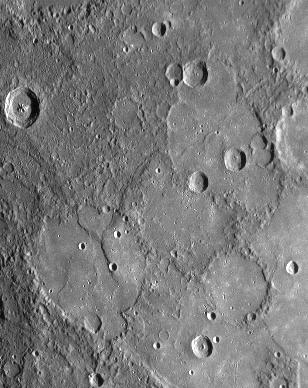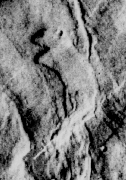Jan 18 2008
Homer Pareidolius
On January 14th the Messenger spacecraft made its closest approach to the planet Mercury. As a reward for our technological prowess and and inclination for discovery we are receiving beautiful images of this small and cratered world. We always expect to be surprised when we turn our instruments in a new direction – in fact we would be disappointed if we were not confronted with something new and unforseen. Even still, I don’t think the NASA astronomers were quite expecting to see the mug of Homer Simpson staring back at them from the surface of Mercury. (see image below the fold)
Then again, maybe they did. Well, at least by now they should expect that the swirls, craters, ridges, and other geological structures they view on the surface of alien worlds may sometimes, quite by random chance, look like something familiar. This is now a well-known phenomenon called pareidolia – seeing a face or a familiar shape in random patterns. Everyone is familiar with seeing a face or animal shape in the clouds or on the bark of a tree or in an oil stain. That is pareidolia.
 Pareidolia is a consequence of the fact that our brains largely work through pattern recognition – making connections among various ideas, memories, or images. We are also very visual creatures and so are particularly good at visual pattern recognition – still better than the best supercomputers (at least for now). The most familiar visual pattern for humans is the human face. Even as infants we prefer to look at human faces over other stimuli. We have a large portion of our visual cortex dedicated to seeing and remembering faces. This is likely due to evolutionary pressures to be able to instantly recognize friend from foe, but also to be able to read subtle facial expressions.
Pareidolia is a consequence of the fact that our brains largely work through pattern recognition – making connections among various ideas, memories, or images. We are also very visual creatures and so are particularly good at visual pattern recognition – still better than the best supercomputers (at least for now). The most familiar visual pattern for humans is the human face. Even as infants we prefer to look at human faces over other stimuli. We have a large portion of our visual cortex dedicated to seeing and remembering faces. This is likely due to evolutionary pressures to be able to instantly recognize friend from foe, but also to be able to read subtle facial expressions.
For this reason we tend to see faces everywhere – our brains are constantly trying to fit random patterns to known patterns, and it knows and prefers facial patterns best of all.
Perhaps the most famous example of astronomical pareidolia is the face on Mars – hailed by the deluded to be evidence of intelligent habitation of Mars in the past, but revealed by high-resolution images to be just a natural mesa formation. But there are plenty of other examples as well. My favorite is the spitting image of Kermit the frog.
So perhaps NASA astronomers should not have been shocked when they saw Homer Simpson on Mercury. Even though I have long since come to grips with the powerful nature of pareidolia, it can still seem uncanny to me how exact an image can appear. The shape of the head, the perfectly matched and positioned eyes, even the trademark five- o-clock shadow – uncanny.
Of course, when we think of all the craters and opportunities for chance configurations, just on Mercury alone, and all the thousands of faces stored in our visual memory, the odds don’t seem that long after all. Also, this is just one of many possible Homer configurations. Here he is looking down and to his right. He could have been looking in a different direction, or had a different expression on his face, or part of his body could have been included. Still, the image is compelling – but that is because our brains will seize upon any suggestion of a facial structure and enhance it to make it seem like more of a fit. It will also fill in missing information – for example, Homer’s right cheek is missing, but that does not detract from the overall effect of the image very much.
The Homer on Mercury is now destined to become a classic example of pareidolia – because it is so pop-culture. Even Richard Hoagland cannot claim that this is the product of an ancient alien civilization (although perhaps I am giving him too much credit – actually he may try to conclude it is a NASA hoax designed to discredit him and the face on Mars – you heard it here first, DOH!). And who doesn’t love Homer.






